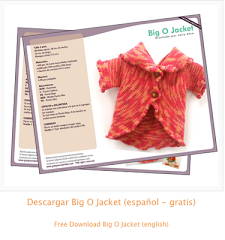There are many ways to bindding off (also known a casting off). A row of bind-off stitches finishes a piece of knitting.
If worked too loosely, the edge will flair and look sloppy. Worked too tightly, the edge will fray and eventually break, especially along edges that are subject to stretching such as necklines.
End each of these bind-off techniques by cutting the yarn and pulling the tail through the last stitch.
Standard Bind-Off
This is the most common, and for many knitters, the only method for binding off, but if you knit all stitches or purl all stitches it produces a very inelastic edge that is unsuitable for cuffs, hems and necks of garments, all of which need to stretch. Use this method only for edges that will be sewn into seams or finished in some way (such as stitches being picked up and knitted)
 1. Slip (or knit) first stitch. Knit next stitch of the row. Insert left needle tip into first stitch on right needle
1. Slip (or knit) first stitch. Knit next stitch of the row. Insert left needle tip into first stitch on right needle
 2. Pull the first stitch on the right needle over the second stitch and off the right needle (1 stitch remains on right needle and 1 stitch has been bound off).
2. Pull the first stitch on the right needle over the second stitch and off the right needle (1 stitch remains on right needle and 1 stitch has been bound off).
 3. The second stitch will now be the only stitch on the right needle. Knit the next stitch on the left needle.
3. The second stitch will now be the only stitch on the right needle. Knit the next stitch on the left needle.
 4. Repeat steps 2 and 3 until the end of the row.
4. Repeat steps 2 and 3 until the end of the row.
When all stitches in the row have been bound off, cut a tail at least 4" long (or as long as the pattern specifies) and pull this tail through the last stitch, pulling to secure the work.
Ribbing Bind Off
This method works similar to the standard method but produces a more elastic edge. Just knit the knit stitches and purl the purl stitches as you bind off.
Suspended Bind-Off
This method is similar to the standard bind-off but produces a more elastic edge. The suspended bind off is used when a loose edge is desired.
1. Knit 2 stitches.
2. Slip the first stitch over the second stitch, but do not drop it from the left hand needle.
3. knit the next stitch, then slip both stitches off the left needle, leaving two stitches remaining on the right hand needle and 1 stitch has been bound off.
Repeat steps 2-3 until no stitches remain on left needle, then pass first st on right needle over the second.
The resulting bind off looks similar to a standard knit bind off, but looser.
Decrease bind off
There are several ways of performing the decrease bind off - by knitting two stitches together, knitting two stitches together through the back loop and purling two stitches together. I'll stick with knitting blabla elegir cual de los tres voy a mostrar.
1. Knit two stitches together through the back loop.
2. Return the stitch back to the left hand needle
Repeat steps 1-2 until all stitches are bind off.
Invisible Ribbed Bind-Off
This method produces a rounded edge that is extremely elastic. It only works for 1 x 1 rib and is ideal for neckbands. Work this bind-off with a tapestry needle. Break off a length of yarn around 3 times as long as the knitting and thread it onto a yarn needle (tapestry needle).
1. insert your tapestry needle as if to purl (purlwise), from right to left, through the first (knit) stitch
2. and pull the yarn through, bring the tapestry needle behind the knit stitch, insert it knitwise (from left to right) into the second (purl) stitch, pull the yarn through,
3. use the tapestry needle to slip the first knit stitch knitwise off the knitting needle, insert tapestry needle purlwise into the next knit stitch
4. pull the yarn through, slip the first stitch purlwise off the knitting needle,
5. bring the tapestry needle behind the knit stitch, insert it knitwise into the next purl stitch and pull the yarn through.
Repeat steps 3-5
Elizabeth Zimmermann's sewn bind off
This method is the stretchiest of all, It is ideal for toe-up socks. Work this bind-off with a tapestry needle. Break off a length of yarn around 3 times as long as the knitting and thread it onto a yarn needle (tapestry needle).
1. Insert tapestry needle into the first 2 stitches on the knitting needle (from right to left) as if to purl (purlwise) and draw the yarn through.
2. Reinsert the needle into the first stitch on the knitting needle as if to knit (knitwise), draw the yarn through and slip the stitch off the knitting needle.
Repeat steps 1-2.
Single crochet bind off
Many people find binding off with a crochet hook to be faster and easier than binding off with two needles.
Use a crochet hook similar to the size of your knitting needles held in your right hand.
1. knit one stitch.
2. knit a second stitch with the crochet hook, then pull the loop of the second stitch through the first stitch.
Repeat steps 1-2




0 comentarios:
Publicar un comentario en la entrada